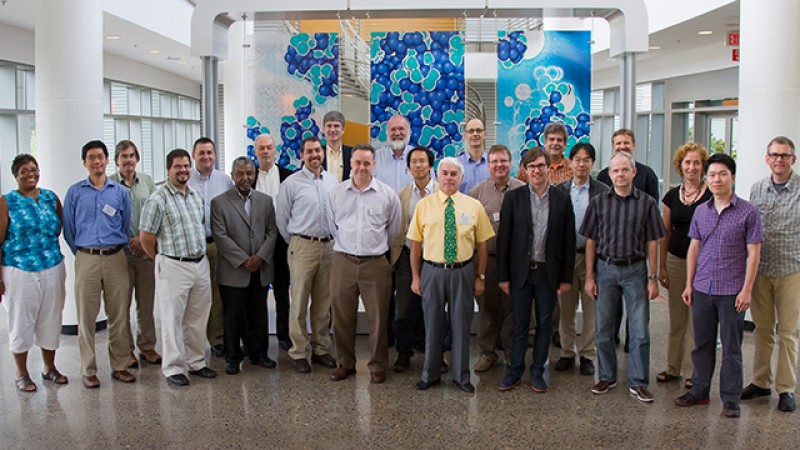Report from the Workshop on Neutron Scattering and High Magnetic Fields (Download the report)
September 4-5, 2013
Matthew B. Stone
Barry L. Winn
Executive Summary
The workshop “Neutron Scattering and High Magnetic Fields” was held September 4-5, 2014 at the Oak Ridge National Laboratory (ORNL). The workshop was held in response to a recent report by the National Research Council of the National Academy of Sciences entitled “High Magnetic Field Science and Its Application in the United States: Current Status and Future Directions.” This report highlights the fact that neutron scattering measurements carried out in high magnetic fields provide important opportunities for new science. The workshop explored the range of the scientific discoveries that could be enabled with neutron scattering measurements at high fields (25 Tesla or larger), the various technologies that might be utilized to build specialized instruments and sample environment equipment to enable this research at ORNL, and possible routes to funding and constructing these facilities and portable high field sample environments.
Participants included principal investigators from U.S. national laboratories and universities. Technical experts were present from the National High Magnetic Field Laboratory (NHMFL) and international facilities. Technical experts and principal investigators from ORNL were also present. Invited speakers on the first day of the workshop focused upon the techniques and challenges associated with neutron scattering measurements performed in high magnetic fields. The invited speakers on the second day focused primarily upon neutron scattering measurements at high magnetic field and important measurements that would be possible with large magnetic field sample environments at the Spallation Neutron Source (SNS) and the High Flux Isotope Reactor (HFIR) at ORNL.
Recommendations to be made to the Neutron Sciences Directorate at ORNL were solicited on both days of the workshop in a town-hall discussion format. While we provide further detail regarding the workshop in later sections of this report, we summarize here the conclusions of these discussions.
- The current operable magnetic field sample environments at the SNS and HFIR do not provide adequate magnetic field strengths to be internationally competitive. The current state of the art high direct current (DC, i.e. not pulsed) magnetic field sample environment for neutron scattering is between 15 and 17 Tesla. Such sample environments are available from commercial vendors and do not require any research or development on the part of the facilities. The current largest operable magnetic field sample environment available at the SNS is a 5 Tesla vertical field magnet. The current largest magnetic fields available at the HFIR are 4.5 Tesla horizontal and 11 Tesla vertical fields. At least one 15 to 17 Tesla split coil vertical field symmetric magnet should be obtained for use at the SNS immediately. An 11 Tesla horizontal field magnet should be purchased for use at the HFIR immediately pending the success of the imminent design review. In order to be competitive and to able to carry out the best science, the ORNL neutron scattering facilities must upgrade their magnetic field sample environments.
- A high magnetic field (40 Tesla or greater) beamline should be considered to be integrated directly into the design and construction of the second target station (STS) at the SNS. This beamline, currently referred to as Zeemans, would be a versatile neutron scattering instrument built around a large horizontal magnetic field sample environment. The current largest magnetic field neutron scattering beamline is built and is currently being commissioned at the Helmholtz Zentrum Berlin (HZB) facility. The magnetic fields available will be between 25 and 30 Tesla. A 40 to 60 Tesla Zeemans instrument at the SNS will enable the next generation of neutron scattering experiments at high fields to be performed. Decisions will need to be made during the planning phases of the STS regarding the magnet technology to be used in the Zeemans high field magnet. These choices will be primarily based on test results on a high temperature superconducting magnet system under construction at the NHMFL.
- Local expertise in the operation, maintenance and development of magnetic field sample environments needs to be established as soon as possible for the ORNL neutron scattering facilities. This will ensure that the magnetic field sample environments remain operational for many years. The operation and maintenance of the Zeemans instrument will also require a group of highly qualified staff.
- ORNL and the NHMFL would benefit from collaborating on specific projects to develop high magnetic field sample environments for use with neutron scattering measurement techniques. This collaboration may involve the establishment of a NHMFL staff and laboratory presence at ORNL. Projects should be strategically chosen to contribute to the development of the Zeemans instrument. These projects may include development and support of a 30 Tesla or greater high repetition rate pulsed magnet and/or a 25 Tesla DC magnet.
- Engagement of US universities is extremely important in developing a suite of magnetic field sample environments at the ORNL neutron scattering facilities. This engagement includes avenues for training and education, and continued feedback concerning ORNL’s progress towards these goals.
In the remaining sections of the report, we provide summaries of the individual presentations made by the invited speakers. We then provide a summary of each of the discussion sessions held during the workshop. We also provide several appendices listing the attendees, the speakers, the agenda, and the status of magnetic field sample environments at ORNL and other neutron scattering facilities.



